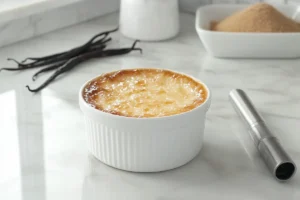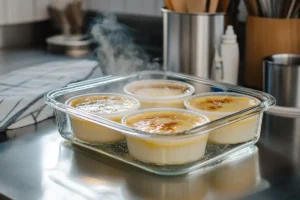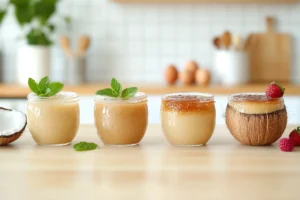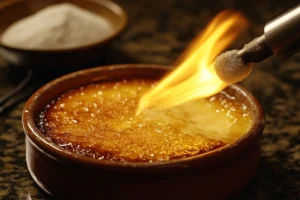Crème brûlée, the classic French dessert, is known for its creamy custard base and crispy caramelized sugar topping. Traditionally, it’s baked in ramekins, those small, oven-safe ceramic dishes that give the dessert its iconic look. But what if you don’t have ramekins on hand? Don’t worry—there are plenty of ramekin substitutes that work just as well, if not better, depending on your needs.
In this article, we’ll explore what you can use instead of ramekins for crème brûlée, from oven-safe mugs to creative alternatives like mason jars and silicone molds. Whether you’re looking for practicality, presentation, or just a fun twist, we’ve got you covered.
Why Consider Alternatives to Ramekins?
Ramekins are great, but they’re not the only option for baking crème brûlée. Maybe you’re hosting a dinner party and need more servings than your ramekin collection allows. Or perhaps you’re experimenting with portion sizes and want something larger or smaller.
Another reason to consider ramekin alternatives is presentation. Using unique containers like mason jars or espresso cups can elevate your dessert game, making it Instagram-worthy. Plus, some alternatives, like disposable aluminum cups, are perfect for large gatherings where cleanup needs to be a breeze.
So, whether you’re out of ramekins or just feeling adventurous, there’s no need to skip making this decadent dessert. Let’s dive into the best substitutes for ramekins and how to use them effectively.
What Makes a Good Ramekin Substitute?
Not all containers are created equal when it comes to baking crème brûlée. The ideal ramekin alternative should be:
- Oven-Safe: It must withstand high baking temperatures without cracking or melting.
- Heat-Resistant: It should distribute heat evenly to ensure the custard sets properly.
- Food-Safe: Ensure the material is non-toxic and safe for baking.
- Aesthetically Pleasing: Since crème brûlée is often served directly in its baking dish, the container should look good on the table.
With these criteria in mind, let’s explore the top alternatives to ramekins for your next crème brûlée adventure.
Best Substitutes for Ramekins When Making Crème Brûlée
When it comes to baking crème brûlée, you don’t need to stick to traditional ramekins. There are plenty of oven-safe containers that can do the job just as well—or even better, depending on your needs. Let’s explore the top ramekin alternatives and how to use them effectively.
Oven-Safe Mugs and Cups
Who says you can’t enjoy crème brûlée in a mug? Oven-safe mugs and teacups are a fantastic alternative to ramekins, especially if you’re going for a cozy, rustic vibe. Plus, they’re perfect for larger servings if you’re feeling indulgent.
Tips for Using Mugs and Cups:
- Ensure they’re heat-resistant and can withstand baking temperatures.
- Avoid mugs with metallic accents, as they can cause uneven heating.
- Fill them only 2/3 full to prevent spillage during baking.
Mason Jars
Mason jars aren’t just for canning—they’re also a trendy option for serving desserts like crème brûlée. Their durability and aesthetic appeal make them a favorite for parties and outdoor gatherings.
Tips for Using Mason Jars:
- Use wide-mouth jars for easier access when torching the sugar topping.
- Ensure the jars are oven-safe by checking the manufacturer’s guidelines.
- Serve directly in the jars for a charming, portable dessert.
Ceramic or Porcelain Bowls
If you’re looking for something elegant, ceramic or porcelain bowls are a great choice. They’re often heat-resistant and come in various sizes, making them versatile for different portion sizes.
Tips for Using Ceramic Bowls:
- Opt for shallow bowls to ensure even baking.
- Avoid bowls with cracks or chips, as they can break in the oven.
- Use decorative bowls for a visually stunning presentation.
Silicone Molds
For those who love flexibility, silicone molds are a game-changer. They’re non-stick, easy to clean, and come in fun shapes that can add a creative twist to your crème brûlée.
Tips for Using Silicone Molds:
- Place the molds on a baking sheet for stability during baking.
- Avoid overfilling, as silicone can be less rigid than ceramic.
- Let the custard cool completely before removing it from the mold.
Ovenproof Glass Dishes
Ovenproof glass dishes, like Pyrex or borosilicate glass, are another excellent option. They’re transparent, allowing you to see the custard set, and they distribute heat evenly.
Tips for Using Glass Dishes:
- Avoid sudden temperature changes to prevent cracking.
- Use smaller dishes for individual servings or larger ones for family-style portions.
- Handle with care, as glass can be fragile.
Mini Pie Dishes or Tart Pans
If you want to get fancy, mini pie dishes or tart pans can give your crème brûlée a professional look. Their fluted edges add a touch of elegance, making them perfect for special occasions.
Tips for Using Pie Dishes:
- Grease the dishes lightly to prevent sticking.
- Use a water bath to ensure even baking.
- Serve directly in the dishes for a polished presentation.
Espresso Cups
For bite-sized desserts, espresso cups are a charming option. They’re perfect for dinner parties or when you want to offer a variety of mini desserts.
Tips for Using Espresso Cups:
- Ensure the cups are oven-safe and heat-resistant.
- Adjust baking times, as smaller containers may cook faster.
- Serve with a tiny spoon for an adorable touch.
Disposable Aluminum Cups
When convenience is key, disposable aluminum cups are a lifesaver. They’re affordable, easy to use, and perfect for large gatherings where cleanup needs to be quick.
Tips for Using Aluminum Cups:
- Place them on a baking sheet for stability.
- Avoid overfilling, as aluminum can conduct heat quickly.
- Serve directly in the cups for a no-fuss dessert.
Creative Alternatives (Sea Shells, Coconut Shells, etc.)
Feeling adventurous? Try using sea shells or coconut shells for a unique presentation. These creative alternatives are sure to impress your guests and make your crème brûlée stand out.
Tips for Using Creative Alternatives:
- Ensure the materials are food-safe and thoroughly cleaned.
- Use a water bath to prevent cracking or burning.
- Serve with a sprinkle of sea salt or toasted coconut for added flair.
How to Successfully Use Alternatives for Crème Brûlée
Using ramekin substitutes for crème brûlée can be a game-changer, but it’s important to know how to use them effectively. After all, the last thing you want is a cracked dish or an unevenly baked custard. Here are some pro tips to ensure your dessert turns out perfectly, no matter what container you choose.
Ensuring Oven Safety
First things first—always check if your chosen container is oven-safe. Not all materials can handle the heat, and using the wrong dish could lead to disaster (think melted plastic or shattered glass).
Quick Checklist for Oven Safety:
- Look for labels like “oven-safe” or “heat-resistant” on the container.
- Avoid materials like regular glass or plastic, which can crack or melt.
- When in doubt, test the container by heating it empty in the oven at a low temperature.
Adjusting Baking Times and Temperatures
Different materials conduct heat differently, which means you might need to tweak your baking time or temperature. For example, metal containers heat up faster than ceramic, so you’ll need to keep a close eye on your custard to avoid overcooking.
General Guidelines:
- Ceramic or Porcelain: Stick to the standard baking time and temperature (usually 325°F for 30-40 minutes).
- Glass Dishes: Reduce the temperature slightly (by about 10°F) to prevent cracking.
- Metal or Silicone: Check for doneness 5-10 minutes earlier than the recipe suggests.
Using a Water Bath
A water bath (or bain-marie) is essential for baking crème brûlée, no matter what container you use. It ensures gentle, even heat distribution, which is key to achieving that silky-smooth texture.
How to Set Up a Water Bath:
- Place your filled containers in a large baking dish.
- Pour hot water into the dish until it reaches halfway up the sides of the containers.
- Bake as usual, ensuring the water doesn’t boil or evaporate completely.
Preventing Spillage and Overflows
Nobody wants a messy oven, so take steps to prevent your custard from spilling over. This is especially important if you’re using shallow dishes or unconventional containers.
Tips to Avoid Spillage:
- Fill containers only 2/3 full to leave room for the custard to set.
- Place the baking dish on the middle rack to minimize movement.
- Use a ladle or measuring cup to pour the custard mixture gently.
Presentation and Serving Tips
One of the best things about using ramekin alternatives is the opportunity to get creative with presentation. After all, we eat with our eyes first!
Ideas for Stunning Presentation:
- Garnish with fresh berries, mint leaves, or edible flowers.
- Dust the caramelized sugar topping with cocoa powder or cinnamon for extra flair.
- Serve with a side of whipped cream or a drizzle of fruit sauce.
Storing and Reheating Leftovers
If you have leftover crème brûlée (though it’s hard to imagine!), proper storage is key to maintaining its texture and flavor.
Storage Tips:
- Cover the containers tightly with plastic wrap to prevent odors from seeping in.
- Refrigerate for up to 3 days.
- To reheat, let the custard sit at room temperature for 10-15 minutes before torching the sugar topping again.
Frequently Asked Questions About Crème Brûlée and Ramekin Alternatives
When it comes to making crème brûlée without traditional ramekins, questions are bound to pop up. Don’t worry—we’ve got you covered! Here are answers to some of the most common questions about ramekin substitutes and baking this decadent dessert.
Can I Use Regular Cups Instead of Ramekins for Crème Brûlée?
Absolutely, regular cups like oven-safe mugs or teacups can work beautifully as ramekin substitutes. However, before you start, make sure they’re heat-resistant and can withstand baking temperatures. Additionally, avoid cups with metallic accents, as they can cause uneven heating and potentially ruin your dessert. For instance, a ceramic mug without any decorative metal trim is an excellent choice. Moreover, these alternatives are not only practical but also add a charming, rustic touch to your presentation. In the end, with the right precautions, you can enjoy a perfect crème brûlée without traditional ramekins.
What Size Should the Alternative Container Be?
For individual servings, aim for containers that hold 4-6 ounces. This size is perfect for a standard crème brûlée portion. If you’re using larger containers, like mason jars or ceramic bowls, adjust the baking time accordingly.
Can I Use Plastic Containers for Crème Brûlée?
No, plastic containers are not suitable for baking crème brûlée. Plastic can melt or release harmful chemicals when exposed to high temperatures. Stick to oven-safe materials like ceramic, glass, or silicone.
How Do I Prevent the Custard from Spilling Over in Non-Ramekin Containers?
To avoid spills, fill your containers only 2/3 full. This leaves enough room for the custard to set without overflowing. Additionally, place the containers in a water bath to ensure even baking and minimize movement.
Can I Use Metal Containers for Crème Brûlée?
Yes, metal containers like disposable aluminum cups or mini pie tins can work, but they conduct heat faster than ceramic or glass. Keep an eye on the baking time and check for doneness 5-10 minutes earlier than the recipe suggests.
Are There Any Creative Alternatives for Serving Crème Brûlée?
Definitely, get creative with options like sea shells, coconut shells, or even hollowed-out fruit halves. However, before you start, make sure the materials are food-safe and can withstand baking temperatures. Additionally, consider the size and shape of the container to ensure even baking. Once you’ve confirmed these details, these unique containers can transform your dessert into the star of the table. For example, imagine serving crème brûlée in a coconut shell for a tropical twist or using a hollowed-out orange half for a citrusy flair. Ultimately, the possibilities are endless, and your creativity will surely impress your guests.
Can I Make Crème Brûlée in Advance?
Yes, crème brûlée is a great make-ahead dessert. Bake the custard as usual, let it cool, and refrigerate it for up to 3 days. When you’re ready to serve, add the sugar topping and torch it just before serving for that perfect crispy caramelized layer.
What’s the Best Way to Caramelize the Sugar Topping Without a Torch?
If you don’t have a kitchen torch, don’t worry—you can still achieve that perfect caramelized topping by using your oven’s broiler. First, sprinkle a thin, even layer of sugar on the custard. Then, place the containers under the broiler for 1-2 minutes. However, keep a close eye on them to prevent burning, as the broiler can work quickly. Alternatively, you can rotate the containers halfway through to ensure even caramelization. In the end, you’ll have a beautifully golden crust without needing any special equipment.
Conclusion: Experimenting with Crème Brûlée Containers
Crème brûlée is a timeless dessert that’s as versatile as it is delicious. While ramekins are the traditional choice, they’re far from the only option. From oven-safe mugs and mason jars to silicone molds and creative alternatives like sea shells, there’s a world of possibilities waiting for you to explore.
The key to success lies in choosing the right ramekin substitute for your needs. Whether you’re looking for practicality, elegance, or a touch of creativity, the right container can elevate your dessert game. Just remember to ensure your chosen dish is oven-safe, adjust baking times as needed, and don’t forget the water bath for that perfect, silky texture.
So, the next time you’re craving crème brûlée but don’t have ramekins on hand, don’t let that stop you. Embrace the opportunity to experiment with different containers and presentation styles. After all, cooking is as much about creativity as it is about following recipes.
Final Tips for Perfect Crème Brûlée Every Time
Before we wrap up, here are a few pro tips to ensure your crème brûlée turns out flawless, no matter what container you use:
- Use High-Quality Ingredients: The simplicity of crème brûlée means every ingredient matters. Opt for fresh cream, real vanilla, and high-quality eggs.
- Strain the Custard Mixture: Straining the mixture before baking ensures a smooth, lump-free texture.
- Chill Before Serving: Let the baked custard chill in the fridge for at least 2 hours before adding the sugar topping. This helps it set properly.
- Torch with Confidence: When caramelizing the sugar, move the torch in small, circular motions for an even, golden crust.
Ready to Get Baking?
Now that you know what you can use instead of ramekins for crème brûlée, it’s time to put your knowledge into action. Whether you’re hosting a dinner party, experimenting with new recipes, or simply treating yourself, this decadent dessert is sure to impress.
So, grab your favorite ramekin substitute, preheat your oven, and get ready to create a dessert that’s as beautiful as it is delicious. Happy baking!




